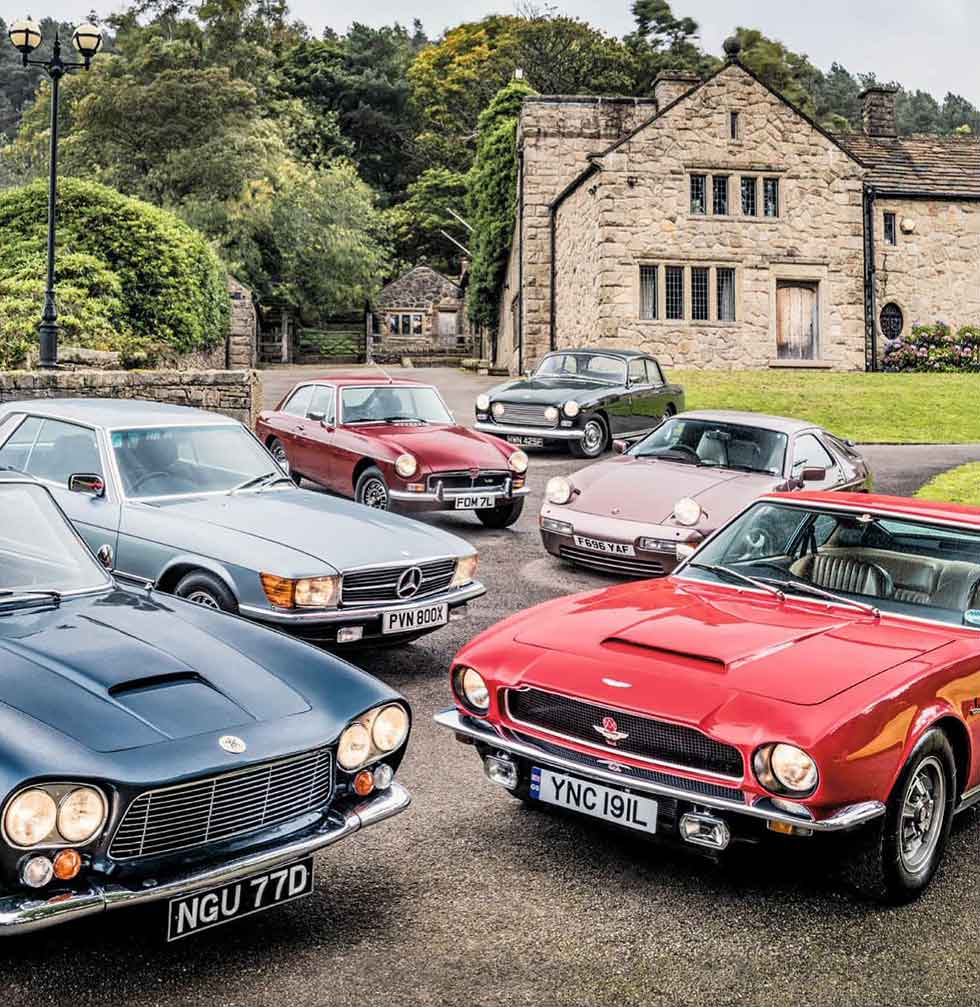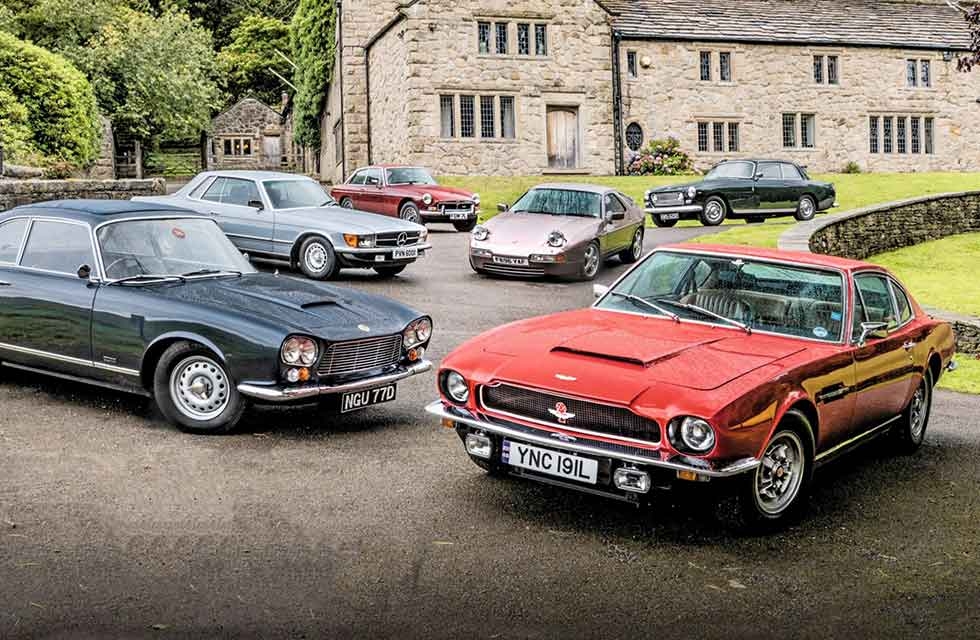
Grand Touring the Peak District in V8 style – but which one’s right for you? ‘It’s a statement. It’s V8 all the way if you have even a hint of rogue in your soul’ V8 For Victory Ross Alkureishi investigates the appeal of a V8 coupé and an open road with Aston Martin V8, Gordon Keeble GK1, Mercedes-Benz 380SLC C107, Porsche 928 S4, Bristol 410 and MGB GT V8 – and how to buy in from just £5k. We take the six current best-value V8 grand tourers on a shakedown tour of the Peak District – and reveal how you can buy in from £5k-£120k. Words Ross Alkureishi. Photography Alex Tapley.
Best powercruiser buys from £5k-120k
V8 GRAND TOURERS

Today’s pre-tour meeting point, Upper House in Derbyshire, was in a past life used as the then-mayor of Manchester’s summer retreat. But what kind of carwould befit such a decadent destination? Priorities include comfort, speed and image. Naturally, it has to be a tin-top. Four-cylinder?
Perish the thought. Straight-six? Too sporting. So a V, but which? Quirkiness eliminates the V4, low-rent image the V6, while the V12 is a bit extravagant and overly complex. Only one thing for it – that V8 sweet spot. It remains the great leveller, classlessly bringing power to the people. Our six choices range in price from £5k-£120k and include sports tourers, smooth boulevardiers and brutish road-burners, all jostling for position of the best-value V8 GT to own.
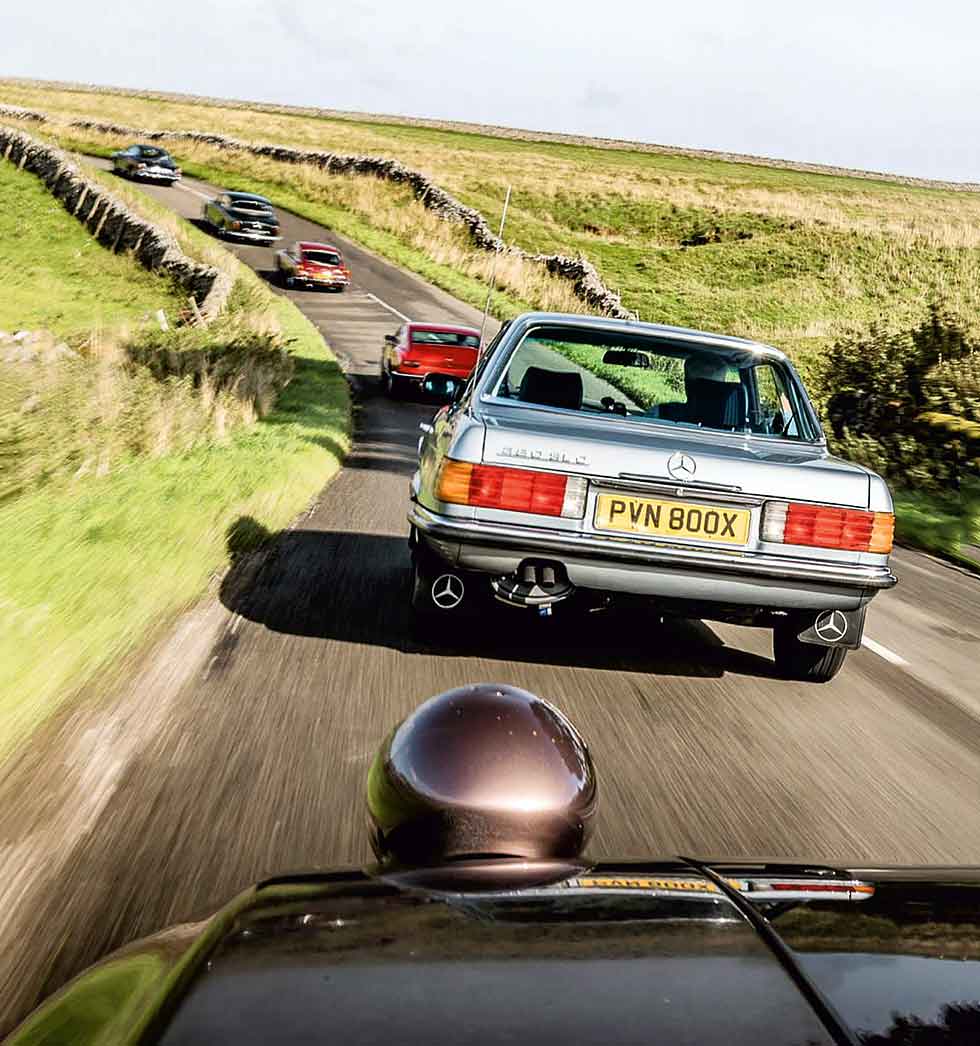
1967 Bristol 410
When asked to pick a favourite from our gathering, the young twenty-something lassies of Upper House’s events team unexpectedly point to the Connaught Green Bristol 410, no doubt charmed by its handsomely restrained lines. Yet the grille-recessed driving lamps, two-door profile and small rear fins see it retain a hint of rakishness, and at the rear a pair of twin tailpipes allude to potency: think perpetual good boy Cary Grant turned bad in Suspicion. Good to know the old boy’s still got plenty in the tank.
From a distance the big Bristol has a debonair bearing. Up close it blocks out the sun. And it could be argued that it has the greatest pedigree here. Surprising, given that there’s a monstrous Chrysler lump under the bonnet, but that power-source snobbery never affected this marque like it did others. That’s because there’s plenty to offset it, most notably the exalted bloodline derived from the mothership, the Bristol Aircraft Company at Filton, as well as numerical exclusivity – just 79 were built.
‘It’s in its element throwing long torqueladen haymakers with effortless effectiveness’
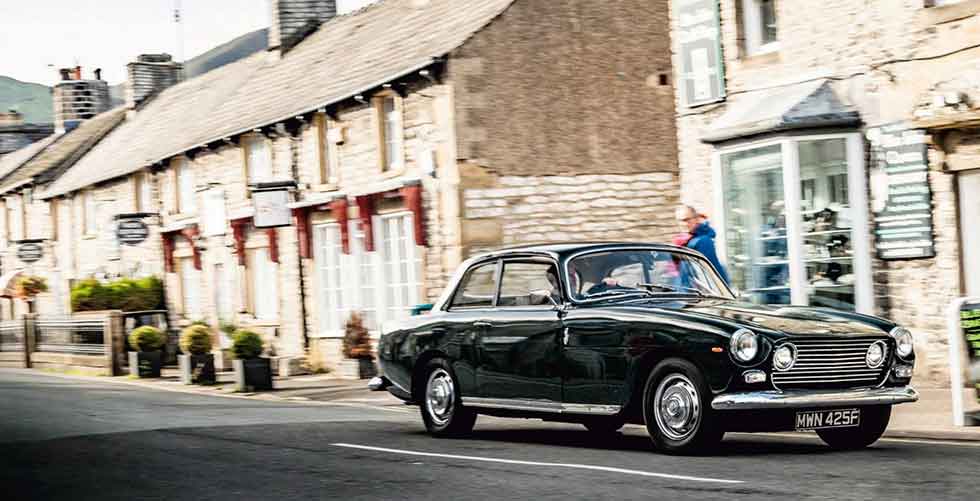
Aeronautical production standards are clear from the 410’s fit, finish and design. The aluminium body’s panel gaps are millimetre-precise, the interior an elegant and well-judged combination of leather, Smiths gauges and luxury carpets. A carriage key is incorporated for opening separate compartments on the outside of each lower front wing, with spare wheel housed nearside and battery, wiper motor, brake servos and fuse box offside. I resist the temptation to hold it up to other owners and state ‘oh you don’t have one – shame.’
Slowly snaking along the wooded driveway at the head of our eccentric convoy, my first impression is of the utter silence in the cabin with the self-levelling rear suspension remaining untroubled by the rocky surface. As we pass through Hayfield village the light rain turns to epic Peak-District downpour, but wafting along the moist A624 is a sure-footed pleasure. I sit commandingly high with excellent visibility. Despite using non-proprietary running gear, Bristol engineers adapted each element to give the desired driving characteristics. The power-assisted steering is light while retaining an agreeable degree of feel, the throttle lustily progressive, Torqueflite gearbox a silky shifter and the dual-circuit brakes powerfully reassuring.
At Chapel-en-le-Frith we turn onto the A6 and I unleash the big guns – 340lb ft of torque soon has the 410’s long snout thrusting along at speed; the cabin is well-insulated, but I can still hear all sorts of more ruffian V8 exhortations in my wake. With peak torque outputs ranging from 197-360lb ft and kerb weights 1001-1811kg, nobody is being left behind today. Despite the heavy metal clamour outside it remains serene in here.
My high-speed high jinks are curtailed as we head towards the heart of the Peak District. Cross-country on tighter corners the big Bristolian is a touch less sure of itself, feeling like a heavyweight in flyweight territory – always a little slow to land its jab. That said, it doesn’t roll particularly badly and there’s no discernable lack of manners from the live-axle rear suspension. Once the road elongates and we sweep onwards, it’s again in its element throwing long torque-laden haymakers with effortless effectiveness.
I wonder what they’re like to buy. Says Richard Hackett of specialist SLJ Hackett, ‘The 410 is sought after because it was the last of the five-litre models. It was a better car than the earlier 407-409 models, with superior handling and brakes; as such it’s more valuable. You’ll pay £40k-£50k for a really nice example, up to £75k for the best. A runner could be £15k and a barn-find could be as low as £5k, but a full restoration at Bristol Cars would cost £100k.
‘If it has holes in the chassis or near where the suspension bolts on then that can be very expensive to rectify,’ says Hackett. Despite having a separate box-section steel chassis and an alloy body, high production standards mean that corrosion between the metals is usually not too bad. However, budget at least £7000 if all four corners require welding and painting.
As Richard states, the 410 remains the pinnacle of the 5.0-litre V8 Bristols and today, underneath its elegant cloche, it’s proved to be a smooth and muscular starter.
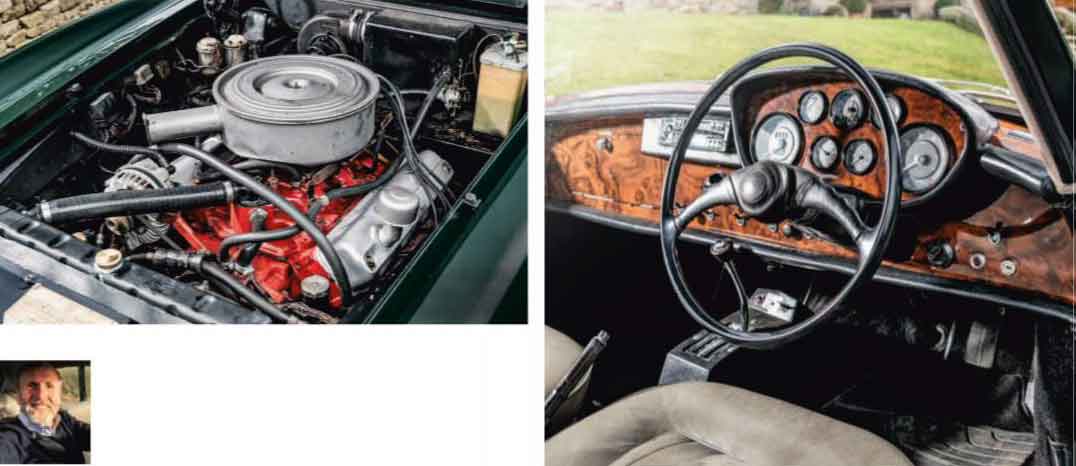
Owning a Bristol 410
Brian Dodd ‘finally’ bought his Bristol 410 in May 2018. ‘I say finally because I first viewed this car in October 2016 at Bristol Cars, but we couldn’t agree a deal. Unbeknownst to me, my son phoned the company in May last year and negotiated a price I was happy with.
A little later I drove it out of the Kensington showroom. ‘Even though it’s over 50 years old it gets driven properly and will keep up with – and ahead of – modern traffic. The V8 is a lovely engine, with plenty of pulling power. I have completed several long journeys since, one a 450-mile round trip to the Goodwood Revival, and it’s performed excellently. ‘So far I haven’t had any major problems sourcing spares and I have found the Bristol Owners’ Club very helpful. The biggest surprise has been the amount of attention it draws, without exception all who look at the car have nothing but positive comments.’
TECHNICAL DATA FILE SPECIFICATIONS 1967 Bristol 410
Engine 5211cc V8, ohv, Carter four-choke carburettor
Max Power 250bhp @ 4400rpm
Max Torque 340lb ft @ 4400rpm
Transmission Chrysler Torqueflite three-speed auto, rear-wheel drive
Brakes Discs front and rear, servo-assisted
Suspension Front: independent by transverse wishbones, coil springs, telescopic dampers, anti-roll bar; Rear: live axle, longitudinal torsion bars, trailing link, transverse Watt linkage, Armstrong Selectaride dampers
Steering ZF recirculating ball steering box, power-assisted
Weight 1600kg (3528lb)
Performance Top speed: 130mph; 0-60mph: 8.8sec
Fuel consumption 14mpg
Cost new £5673
Classic Cars Price Guide £15,000-£50,000
1988 Porsche 928 S4
We stop in the village of Peak Forest, an anachronism – forestation peaked in the 13th century, by the 15th it was gone. I swap the sublime for the ridiculous; that is, the 410’s traditional lines for the apparition of Eighties modernism that is the Porsche 928 S4. And in pink, too! Lord, you have to admire that decade’s excesses. Okay, so it’s Germanly known as Cassis Rot Metallica, but there’s no denying its visual impact.
Come 1986 and the late-Seventies original received a makeover, resulting in a smoother, longer profile and considerably less toothy front-end. The dead shark eyes remained, but it gained an undertray and tail spoiler that reduce drag from 0.39 to 0.34Cd. Up front the majestic V8 – now in 5.0-litre form – was upgraded to four valves per cylinder for a tub-thumping 320bhp and 317lb ft.
‘The sheep-dotted open green pasture on either side now just blurs into Pacer mint stripes’
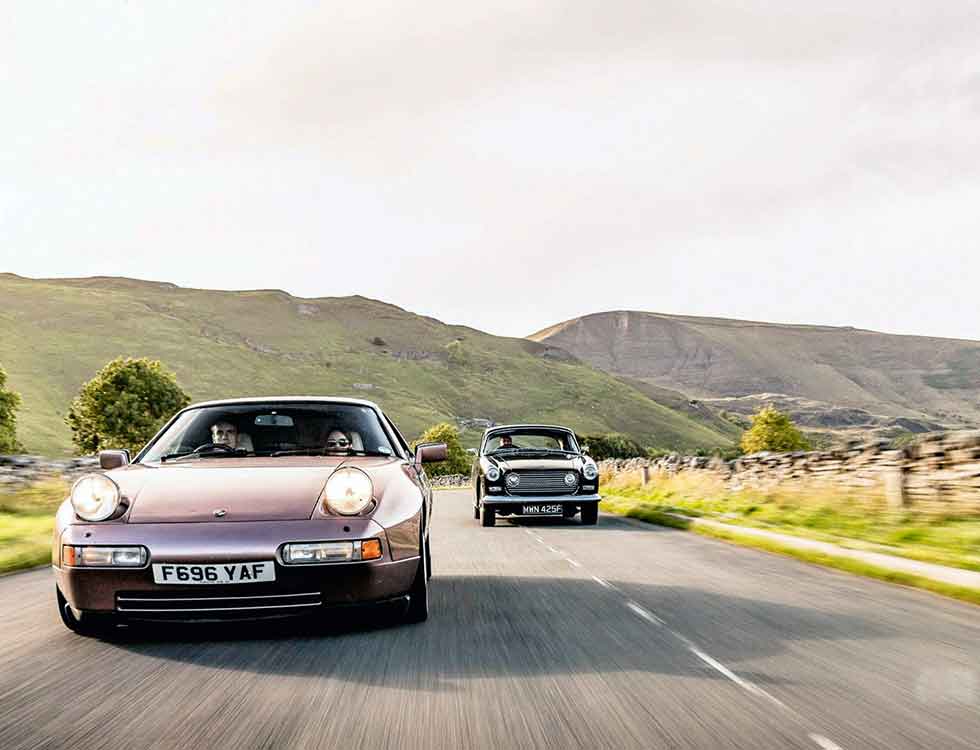
I’m about to start lamenting the absence of a trippy Seventies Pasha checkerboard interior but popping the substantial, unmistakably shaped door reveals a study in Burgundy. With linen-coloured leather and carpets, it’s like a lounge lizard’s boudoir – although no low-rent lothario’s entertainment space would be constructed half as well as this. I love it, the antithesis to the usual factory-issue all black. With the engine already running it’s ticking over with a louder burble than I recall of other 928s – thanks here to a custom stainless steel exhaust system.
A thumbs-up to my fellow drivers is greeted by matching replies and broad smiles, denoting that the soggy conditions aren’t dampening spirits. I slip down into the 12-way adjustable seat, make myself comfortable then pop the Mercedes-derived four-speed automatic gearbox into drive, release the fly-off handbrake and unintentionally, but cheekily, wheelspin one of those wide rear boots – with great power comes even greater responsibility – and we’re off again.
Breaking free of the last few dwellings I plant my foot. There’s a thump as the gearbox performs a double-kickdown, that semi-hexagonal rump squats, orange instrument needles – already zinging against their black background – start spinning and the 928 piledrives forward at warp speed. The sheep-dotted open green pasture on either side now just blurs into Pacer mint stripes.
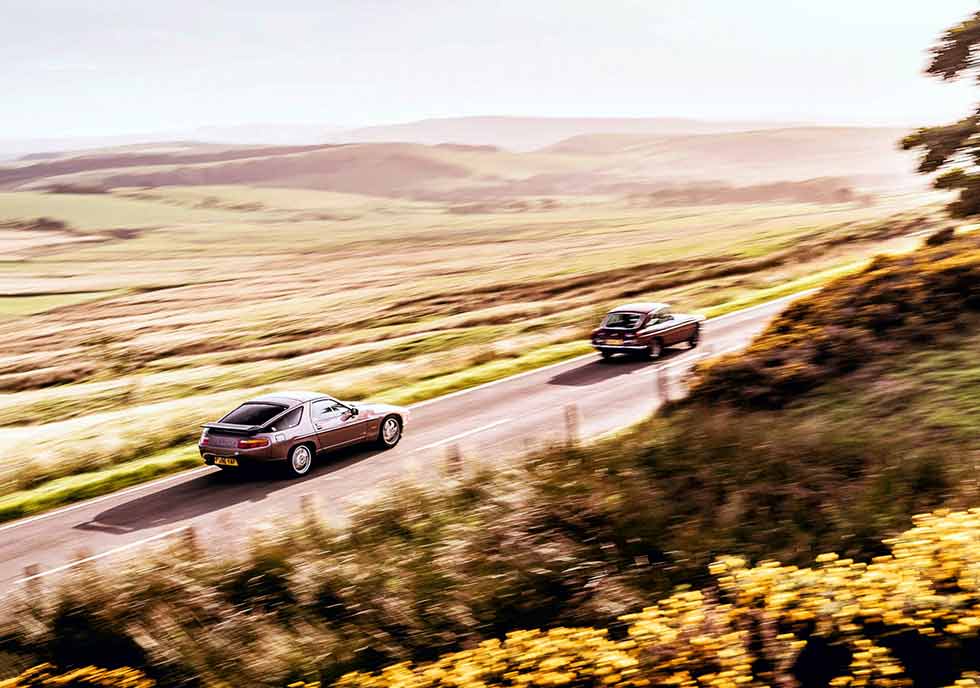
Down boy. Climbing higher into the White Peak, with a tight left-hander approaching and the speedometer nonchalantly threatening three figures, I back off using the powerful four-piston brake calipers, their brutal effectiveness quickly bringing the car back to sensible cruising speed. Yet the innovative Weissach rear axle – generating toe-in under deceleration – gives such confidence that I can take the next even-tighter right-hander quicker still.
We batter on south through Bakewell towards Rowsley. Inside the cabin the V8 snarls under load, but it remains discreet – it doesn’t sing like an Italian, or announce its arrival bellicose like a V8 muscle car. Its sheer efficiency doesn’t offend me as it might have done ten years ago – would I still put a louder exhaust on? Yes. Would it ruin it? Probably.
Tempted? Porsche Enthusiast Club’s Vince Dallimore says, ‘Find someone who knows the 928. It’s a complex car, and risky to buy just on looking around. Typically any 928 was looked after and serviced properly for the first ten years, but as values fell that wasn’t always upheld. Servicing is key – be wary of 928s with little history.
‘Auto 928s in particular are prone to thrust bearing failure because of a pinch bolt holding the torque tube flex-plate in place If it’s not released and checked, it’ll eventually push the flex plate towards the flywheel, forcing the thrust bearing in the middle of the crankshaft into the cylinder block. It’s pretty much the death of an engine, and you’re looking at £6k-£7k for a secondhand unit that could have a similar problem. Matching numbers credibility would also be gone. However, a specialist can easily check it.
‘You can pick an S4 up for around £7k, but you’ll probably end up spending £15k-£20k bringing it up to scratch. Decent ones are in the upper teens to £20ks for a good auto; only 38 rhd S4 manuals were made for the UK market so those can be up to £40k.’
Worth it? On narrow, tight and twisting tarmac the variable assistance steering is satisfyingly direct, but sheer heft reveals the 928 to be no precision tool like its 911 cousin – it takes more of a bludgeoning approach to corners. But back on the A6 its distance-devouring capabilities are beyond doubt.
Owning a Porsche 928 S4
‘Our friend Jason emigrated to Canada two and a half years ago,’ says Stefanie Aldridge. ‘We bought two 924s from him but when we collected them we saw ‘Cassie’, and suddenly we were coming home with three Porsches.
‘She cost £3500 and we’ve focused on restoring the mechanicals. New suspension, brakes, bushes and injectors were fitted and the aircon refurbished. We replaced all gaskets, hoses, seals and belts. Some parts are easy to source, some are not; we get some from a breaker’s yard that has 928-specialist support, and use social media groups such as 928 Passion to post questions.
‘My partner Gareth and I do most work ourselves, so I’d guess we’ve spent around £5k-£6k. We recently took her to Poland – via Holland, Germany, Czech Republic and Austria – for a wedding. It was 5500 miles of heaven.’
TECHNICAL DATA FILE SPECIFICATIONS 1988 Porsche 928 S4
Engine All-alloy 4957cc V8, sohc per bank, with Bosch K-Jetronic fuel injection
Max Power 320bhp @ 6000rpm
Max Torque 317lb ft @ 3000rpm
Transmission Four-speed automatic, rear-wheel drive
Brakes Discs front and rear, ABS
Suspension Front: independent by double wishbones, coil springs, telescopic dampers, anti-roll bar;
Rear: lower wishbones, upper transverse link, coil springs, telescopic dampers, anti-roll bar Steering Rack and pinion, power-assisted
Weight 1590kg (3505lb)
Performance Top speed: 165mph; 0-60mph: 5.7sec
Fuel consumption 16mpg
Cost new £52,424
Classic Cars Price Guide £5000-£27,500
{module Porsche 928}
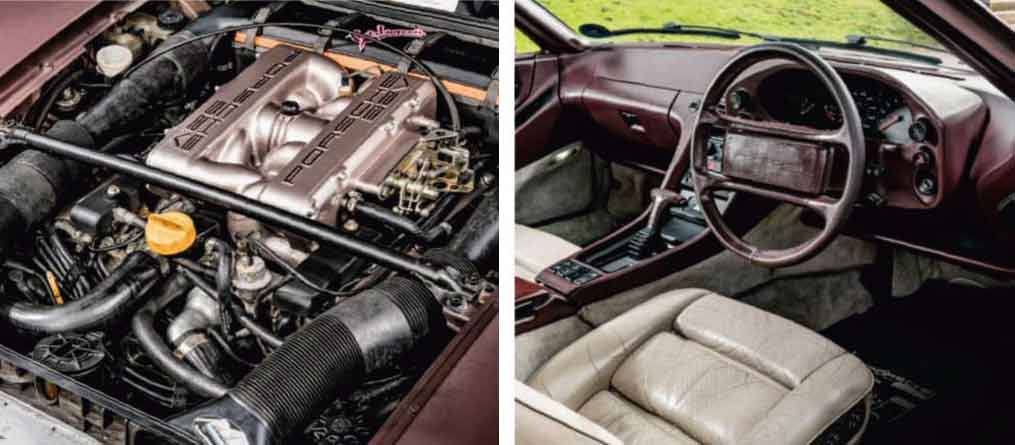
1975 MGB GT V8
The MGB GT V8 was no laughing matter for Ken Costello. The ex-Mini racing driver had proven that the Buick-sourced/Rover-tweaked light-alloy V8 could be squeezed into an MGB engine bay, producing an altogether fruitier performance proposition. After British Leyland examined an example, his engine supply dried up. Hey presto, in 1973 MG’s own version arrived – coincidence?
We’ve run out of District to the east, so it’s time to head north. I do an auditory double-take as my key turn is greeted by a muffled V8 burble; throttle-blips of beefiness elicit a recurring smile. The clutch is light, that upright gearlever won’t be rushed, but oh my, that torque – some 75% more than the four-cylinder MGB GT – pushes this little tyke along keenly.

I’m third in line, sandwiched between the Aston’s considerable rump and the 928’s frog-eyed expression. Trees flash past either side as Aston owner Ian Hill presses on, but there’s no need for me to downshift – I just squeeze the throttle further and the GT V8’s Damask Red nose stays pinned to his tail. I watch him looking in the rearview mirror, the MG and V8 badges looming. A modest 137bhp and 193lb ft of torque makes it the lowest-powered car here, but factor in who ate all the pies – certainly not our svelte 1001kg charge – and it’s just 0.2sec slower to 60mph than the Newport Pagnell snorter. No wonder this provided such a hoot to MGB fans when new. Suddenly they had themselves a big game hunter.
We cross the River Derwent climbing steadily to reveal Chatsworth House in all its stiff-upper-lip glory, and looking as British as, well, the MG – if a touch higher rent. The ubiquitous ’B in all its forms evenly shares the definitively Sixties British sports car tag with the Jaguar E-type. The V8 has those same smart exterior lines, adorned with an abundance of chrome, and appealing, comfortable interior. The alloy V8 engine made it only marginally heavier – unlike the leaden ’C – so it also retains the innate sports car handling of the four-cylinder cars. It’s by no means as refined as the others here – noisy compared to the airtight Bristol and Porsche cabins – but it’s proving to be more at home than all of them when devouring back roads, and it’s one heck a of a lot cheaper to own.
‘No wonder the GT V8 provided such a hoot to MGB fans when new. Suddenly they had themselves a big game hunter’
Says Victor Smith of the MG Car Club’s V8 Register, ‘A chrome-bumper MGB GT V8 carries a slight premium over a later rubber-endowed example, but prices of both vary depending on condition. Around £7000 will buy a runner, rising to £14,750 for a condition 2 example, £20,600 for condition 1 and anywhere between £25,000 to £35,000 for an exceptional car. However, because of poor rust-proofing when new, most 45-year-old V8s will have had some restoration; close inspection of the quality of work and knowing who carried it out is essential. You don’t want to pay for a condition 1 car, only to find later it’s in need of refurbishment or worse – a serious restoration can cost £15k-£25k, or more!’ As such, inspection of the sills and adjoining bodywork is a must. Corrosion in the former can affect the structural strength and integrity of a car, and necessitate major restorative work.
‘Another useful check is the engine oil,’ says Smith. ‘The Rover V8’s lubrication system is a low-pressure, high-volume one, so regular oil changes at 3000-mile intervals are essential to avoid sludge build-up in the oil passageways leading to the rocker shaft, and consequent wear. The oil should be near a golden colour. If it’s black and dirty that’s not a good sign.’
The V8 Register offers lots of advice and support, including buying and price guides, articles, checklists, and maintenance tips, as well as over 500 spares for sale.
The prosaic reality of the brand’s then-reduced image as suppliers of affordable sports cars for the masses means it’s the least likely of our cars to have graced a country house driveway when new, but it propelled the MGB into a different performance league. The joke though was on British Leyland, because it all came a decade too late. The V8’s other mechanicals – including lever-arm dampers, live axle and cart springs anchored firmly in the previous generation – were judged insufficient to justify the £2293 price tag, with V8 badges and Dunlop composite steel rim/ alloy centre wheels the only exterior additions. The public was not amused and just 2591 sold, which today makes it bloomin’ rare.
Owning an MGB GT V8
Keith Belcher bought this MGB GT V8 in 1991. ‘I’d owned several MGBs, but not a V8. After a test drive I was smitten, and paid around £6500. I laid it up in ‘1994 when life got in the way, and when I retired I was looking for a 993-generation Porsche 911, but couldn’t find one I liked. My family and best mate talked me into bringing my GT V8 back to life instead.
‘I spent £3000 re-commissioning it for the road, followed by £9000 on a light restoration and haven’t regretted the decision. It’s a pleasure to own. The sound and abundance of torque is addictive, even after 27 years. The gearbox is a weak spot, so you need to be aware and treat it with respect. However the bodyshell and engine are well proven. ‘Parts are plentiful and cheap, but you get what you pay for. Specialist support is excellent, especially from the superb V8 Register website, v8-register.net.’
TECHNICAL DATA FILE SPECIFICATIONS 1975 MGB GT V8
Engine 3528cc V8, ohv, twin SU HIF6 carburettors
Max Power 137bhp @ 5000rpm
Max Torque 193lb ft @ 2900rpm
Transmission Four-speed manual with overdrive, rear-wheel drive
Brakes Discs front, drums rear, servo-assisted
Suspension Front: independent by upper and lower wishbones, coil springs, lever-arm dampers, antiroll bar; Rear: live axle, semi-elliptic leaf springs, lever-arm dampers
Steering Rack and pinion
Weight 1001kg (2427lb)
Performance Top speed: 125mph; 0-60mph: 8.6sec
Fuel consumption 23mpg
Cost new £2293 in ‘1975 CC
Price Guide £7000-£20,000
{module MG MGB Club}
‘Throttle-blips of beefiness elicit a recurring smile’
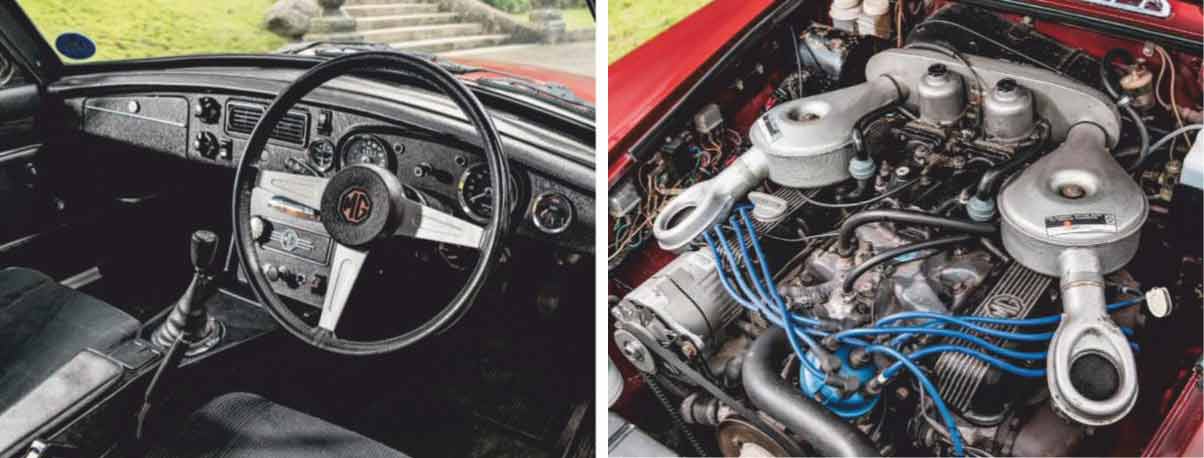
1981 Mercedes-Benz 380SLC C107
Lunch scoffed in picturesque Castleton, banter shared and owner bonds strengthened, we’re off towards Edale for a loop around the Great Ridge. The rain’s stopped and my steed is the fine Mercedes-Benz SLC owned by Justin Marozzi– a trusting type of chap, handing over the keys having only just bought it. We’re on the border of sandstone and limestone country here, but the ’107 Merc looks as it always has – hewn from granite. Even its Fuchs alloy wheels are stylishly sober. At the R107’s launch in 1971, gone was the predecessor Pagoda SL’s delicacy of line, replaced by an altogether blockier Seventies aesthetic.
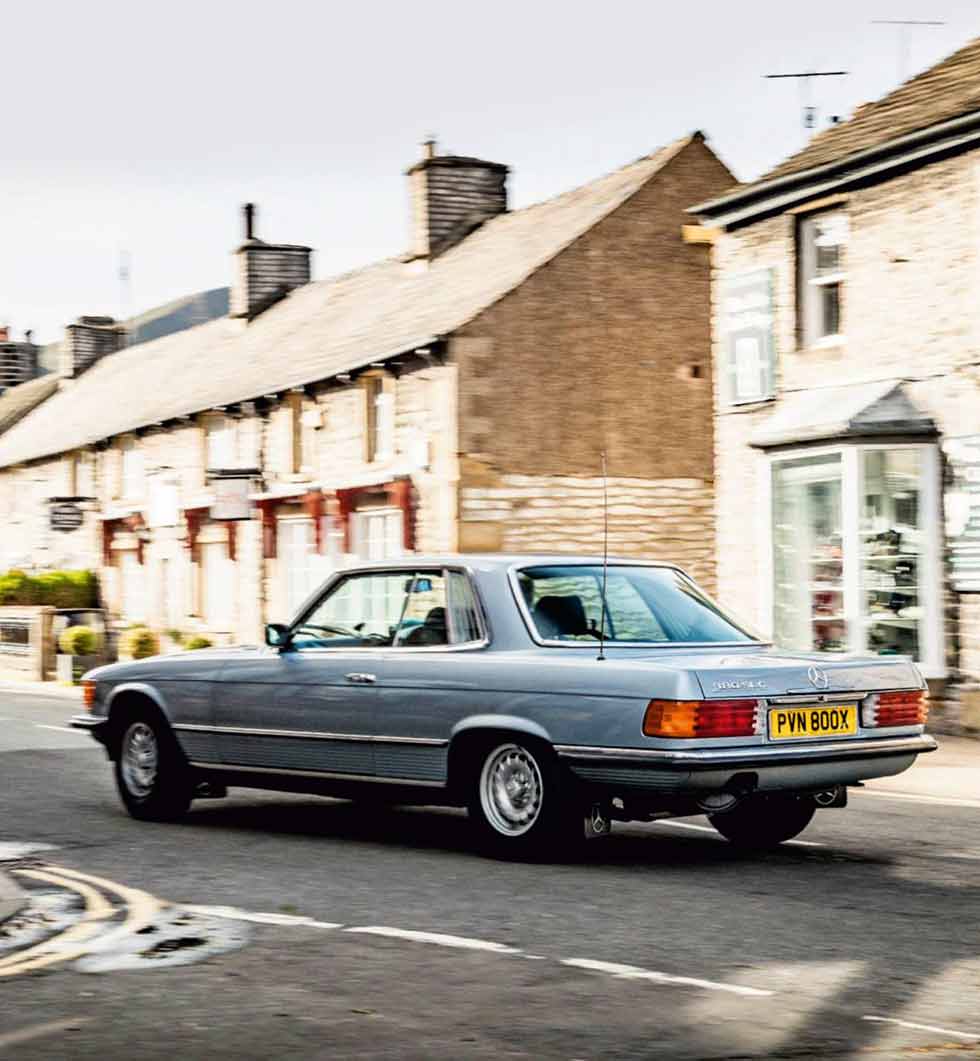
Underneath sat a sophisticated modern suspension arrangement with power only coming, initially at least, in 3.5- or 4.5-litre V8 forms. The following year saw a new model, the C107 SLC, with a 14-inch-longer wheelbase and a fixed roof, to ensure der Panzerwagen finally fully deserved its nickname.
I’m smitten even before I enter an interior of deep blue velour and walnut trim – you’d half expect the lounge of Margo Leadbetter from The Good Life to look like this. This example has the all-alloy 90-degree V8 from the 1980 range re-jig, here in its sweetest 3.8-litre form. It fires proficiently, settling immediately into a hushed tick-over. Windows down for full pillarless panache, I pour the SLC into traffic. Sade’s Smooth Operator floods the cabin on cue, causing much mirth.
Apt though. The Mercedes’ controls ooze quality, as do its fittings and finish. Thrust comes in progressive, creamy waves – a gentle nose-dip on shifts the only indicator that the four-speed automatic gearbox is at work. Climbing up through the untamed beauty of Winnats Pass, the V8’s 279lb ft of torque dispatches the limestone gorge’s 1:3.5 gradient with nonchalant ease.
‘Under heavy load the carburettors squabble like baritone hellcats. The hills are alive with the sound of V8, to the multiple of six’
Passing Mam Tor heading into the Dark Peak, the road narrows perceptibly. The SLC is wide, but its suspension is more forgiving than the 928, dealing with the less than perfect road surface impeccably. Brakes are potent – a good thing, given the oncoming car. Breathe in, then exhale once past and nail the loud pedal – or quiet pedal, in this case. A deep thrum is the most I get; it’s thoroughly restrained even when pressing on. The Merc is surefooted through a mischievous sequence of twists, the double wishbone/semi-trailing arm suspension set-up lending the impression of a silent rollercoaster gliding on its tracks. This is not a car to drive like a hairy canary; 75%of its limits is the sweet spot.
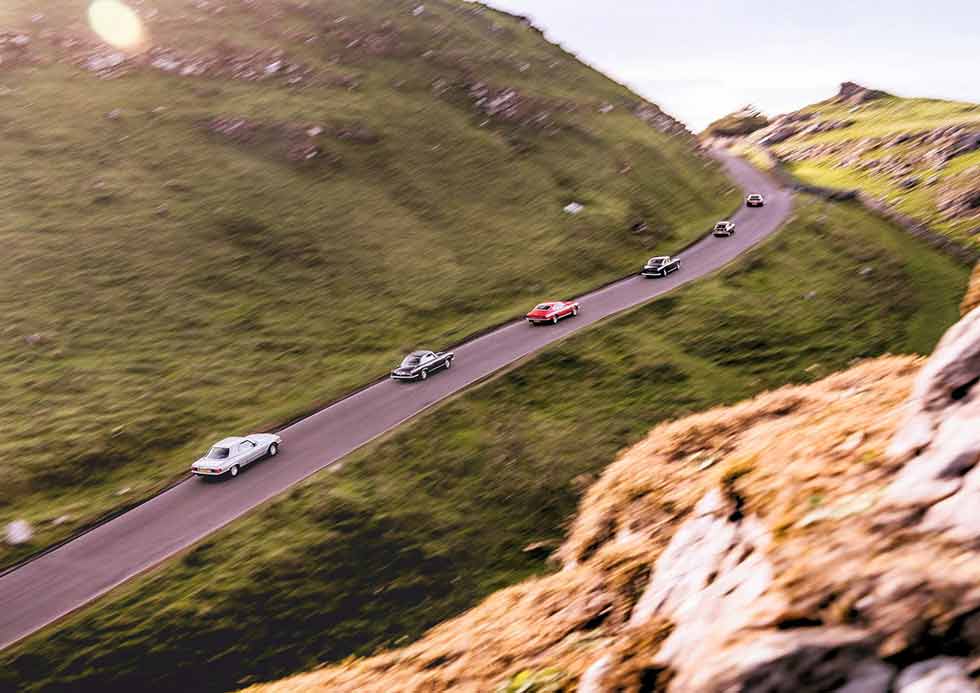
What price, such luxury? The SL Shop’s Sam Bailey says V8 SLCs carry a 20% premium over their six-cylinder brethren. ‘There are so few it’s all about condition and provenance. Prices vary accordingly from a rough runner with MoT for £3000, through to a good example at £15,000 and an exceptional one £30k-£40k.
‘The bulkhead plenum chamber alone can be upwards of £3000 to restore if corroded. ’With a full body restoration starting at £20k for fabrication and panels, and a further £5k-£20k depending on quality of paint required, it’s clearly wise to invest in a good one. Best of all, the addition of that tin-top means it’s available for up to 40 per cent less than the convertible.
‘Sade’s Smooth Operator floods the cabin on cue, causing much mirth’
‘The other main issue is with the fuel injection, but only on 350 and 450 models. These use electric Bosch D-Jet and K-Jet systems, rather than the problem-free mechanical unit; if the system is contaminated or has a number of tired parts you can easily spend £3k-£4k putting it right. This would manifest itself with the V8 starting poorly from hot or cold, misfiring, running unevenly and using even more fuel than it should.’
At the village of Hope – abandon all, ye who enter – the sun breaks through the lightening sky – if only we had a convertible top! Of course, this is the reason the SLC has remained relatively unloved over the last few decades; the SL’s purpose was roof-down cruising. However, if that is of no consequence then there’s a bargain to be had. You’ll even get two fully formed adults in the rear. A double-date to a West End show? ‘We’ll take the SLC, darling.’
Owning a Mercedes-Benz 380SLC
‘I’ve owned this 380SLC all of a fortnight and I’m already in love with it,’ says writer and historian Justin Marozzi. ‘After a year larking about in a Lotus Elan Sprint, it was time to grow up and exchange lightweight Norfolk glassfibre for heavyweight German steel. ‘I found it at the SL Shop and the first drive back from Stratford upon Avon to north Norfolk was 150 miles of wafting wonder – oodles of creamy, magic-carpet V8 Panzerwagen naughtiness.
‘After the ludicrous thrill of back-road blasting in the Lotus, the SLC couldn’t be more different; the joy comes from its solidity, quality and refinement. I used to think half the fun of owning a classic car was not knowing whether I’d make it to my intended destination. For some reason my wife never saw it like that. Now it’s not an issue.
’If the first few weeks are anything to go by, my main expenditure will be petrol!’
TECHNICAL DATA FILE SPECIFICATIONS 1981 Mercedes-Benz 380SLC C107
Engine 3818cc V8, sohc per bank, Bosch fuel injection
Max Power 225bhp @ 5000rpm
Max Torque 279lb ft @ 3000rpm
Transmission Three-speed auto, rear-wheel drive
Brakes Discs, servo-assisted
Suspension Front: double wishbones, coil springs, telescopic dampers, anti-roll bar; Rear: semi-trailing arms, coil springs, telescopic dampers
Steering Recirculating ball
Weight 1635kg (3601lb)
Performance Top speed: 134mph; 0-60mph: 8.8sec
Fuel consumption 18mpg
Cost new £10,435
CC Price Guide £3k-£16k
{module Mercedes Benz 107}

1973 Aston Martin V8
Brutal was the word I used to describe the Porsche 928S4’s looks, but where do you go from there when it comes to the Aston Martin V8? In ’1972 the design team went to, ahem, town on the original William Towns-penned DBS V8’s supertanker lines. The result – including single headlamps, a lower front wing line and a return to a more traditional Aston grille shape – was as far removed as could be from the company’s elegant sporting output of yesteryear. Gone too was the DBS moniker, with the new model known simply as the Aston Martin V8. The following year, just as many manufacturers were heading in the opposite direction, Aston ditched fuel injection for a return to carburetion.
Look at it oozing malevolent intent, amplified here by its Fiesta Red paint. I’m genuinely worried for the health of this village’s old biddies should we linger any longer. Ensconced in the bespoke interior, I prime the quad Webers with a couple of foot pumps and detonate the 5340cc four-cam V8. I’m not sure that’s helped make us any less conspicuous. Like the rest of this behemoth, the noise is about as tactful as Brian Blessed tonked up on Red Bull reading a bedtime story on Jackanory – time for a sharp exit.

The driving position is effective; huge comfortable leather seat, clear dials set in the cowled crackle-black dashboard and a meaty, dished leather steering wheel sitting within perfect reach. The throttle pedal is firm, and I’m glad of the now-dry tarmac as I power down. Under heavy load the combination of raucous roar up front, as the carburettors squabble like baritone hellcats, and the twin cannonade from the rear is simply glorious.
‘The Aston V8 is about as tactful as Brian Blessed tonked up on Red Bull reading a bedtime story on Jackanory’
We’re soon flashing past the Ladybower Reservoir. There’s not a cloud in the sky now and the hills are alive with the sound of V8, to the multiple of six. As we cross the water we turn onto the A57, Snake Pass. The Aston is proving a supremely comfortable and exhilarating machine to pilot. I quickly get familiar with using the relentless reserves of mid-range torque to nip past the odd dawdler. However, like 410, ’B GT V8 and SLC, it’s not a seriously quick car. Despite 280bhp (to 340bhp, depending on which period source you believe) and 320lb ft of torque, it’s limited by its 1811kg kerb weight – pies indeed. To go faster you need an engine upgrade, or to reach for a Vantage. But should I be afraid of the ownership realities?
‘Values vary hugely depending on specification, rarity and condition,’ explains RS Williams’ Stuart Draper. ‘There are numerous examples out there that are to be avoided. Sills need checking, because to restore them properly costs £9k-£12k per side.’ If that isn’t enough to warn you off that cheap eBay V8, then the £300k-£360k cost of a complete restoration might. ‘It’s definitely worth ensuring a specialist looks over a car for you before committing.’
Draper always recommends checking the service history to see how the car has been maintained, and by whom. ‘Check the engine thoroughly, or budget in a £34,500 rebuild to factory spec.
‘A ‘barn-find’ automatic example could start £40k; a superb original manual example could be upwards of £250k. Specification wise, the latter is the way to go. Colour choice doesn’t matter greatly unless it’s been painted in a non-period one. Prices are still some way off Vantages, the very best of which are around £450k+, and they’re still providing good investment potential.’
Nipping off for a quick cross-country tumble is a hoot. The V8 is fairly adept, its de Dion rear axle a surprisingly forgiving servant and the steering sends clear messages to your fingertips. But it’s an all-round upper body workout. I’d expected unruly barge, but despite its sheer heft, the brakes – with twin servos, with front and rear ventilated discs – will pull the big boy in sharply when required. This car remains at its best hard-charging on high-speed roads, sweeping through the countryside to loom large, menacing the rearview mirrors of lesser machinery.
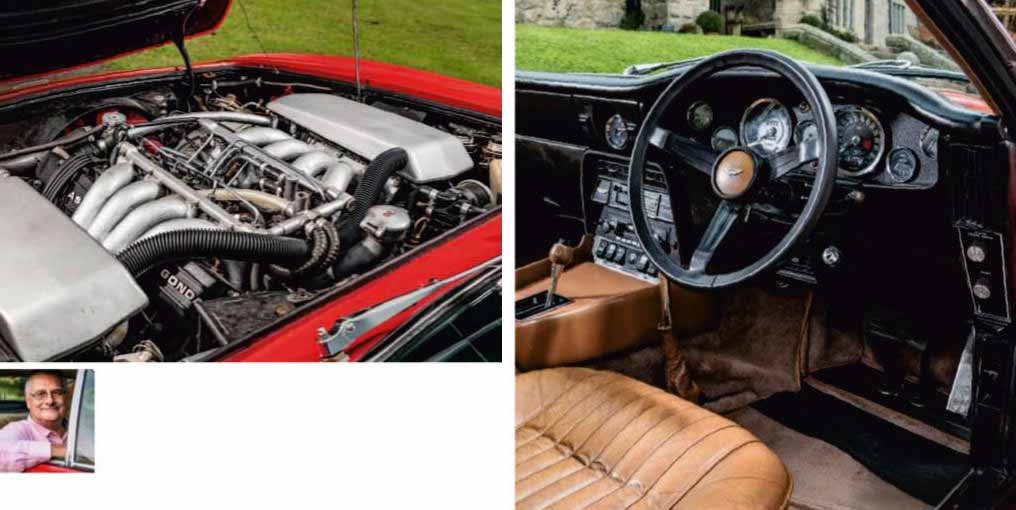
Owning an Aston Martin V8
‘My father acquired this V8 in April 2001, and it came into my ownership in 2009 when he passed away,’ explains Ian Hill. ‘Having had a DB4, ’5 and DBS Vantage, this was his Aston Martin swansong. At the time these were the only affordable way into Aston ownership.
‘Today I budget £2k-£3k a year to run it, and that includes petrol at circa 10-12mpg, but in truth it does very little mileage. It starts first time, every time, even if it’s been laid up for several months and I’ve never had any unexpected issues that you would be surprised with on a 45 year-old car. However, I’ve had the steering rack replaced at £9000 because it was leaking, probably down to lack of use – the car has only done 51,000 miles.
‘It’s definitely a car I intend to keep hold of and pass down to my son and grandson.’
TECHNICAL DATA FILE SPECIFICATIONS 1973 Aston Martin V8
Engine All-alloy 5340cc V8, dohc per bank, four Weber 42DCNF twin-choke carburettors
Max Power 280bhp @ 6000rpm
Max Torque 320lb ft @ 3000rpm
Transmission Five-speed ZF manual, rear-wheel drive
Brakes Ventilated discs, servo-assisted
Suspension Front: independent by wishbones, coil springs, telescopic dampers, anti-roll bar; Rear: independent by de Dion axle, trailing links,
Watt linkage Steering Rack and pinion, power-assisted
Weight 1811kg
Performance Top speed: 145mph; 0-60mph: 7.5sec
Fuel consumption 16mpg
Cost new £12,765
CC Price Guide £40k-£120k
{module Aston Martin DBS / V8}
1966 Gordon Keeble GK1
Gordon Keeble, didn’t he play right-back for England during the Fifties?’ That’ll be a no. I’ve even had blank stares from people heavily into their classics, but blink and you’d have missed the Gordon Keeble GK1’s production run.
It’s been clear today that Mike Webster’s fellow owners have had a bad case of exhaust envy. By jings, it sounds glorious. The cause? The smallblock matter of a 5.4-litre (327ci) Chevrolet Corvette V8 hiding snugly under its bonnet.
In 1959 at the behest of USAF pilot Rick Neilson, Ipswich-based garage owner and engineer Jim Keeble adapted a Peerless Cars chassis to accept a Corvette engine. From there things snowballed; Peerless MD John Gordon came on board, a 21-year-old Giorgetto Giugiaro at Bertone designed the body – his first design – and Keeble the spaceframe chassis. The prototype Gordon GT – endowed with a 4.6-litre Chevy V8, de Dion rear axle, Girling disc brakes, Armstrong Selectaride dampers and a Warner four-speed manual gearbox – was ready within a barely believable four months. By the time finances allowed for it to go into production four years later, Gordon had gone but the name remained, with Keeble’s added to reflect his part in its design. Oh, and the more economical choice of glassfibre had replaced the steel body.
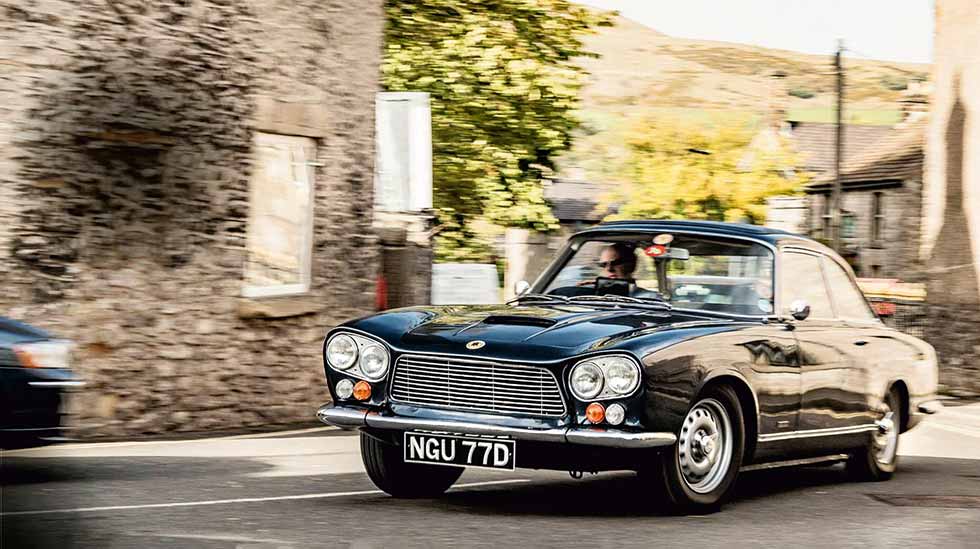
Let’s see what £2798 got you back then. I’m conflicted. The slanted headlight arrangement has never really appealed to me on other cars, but on the GK1 it just works. Aided by an ultra-low waistline, elegant rear and simple Dunlop pressed-steel wheels with three-eared centre locks, it presents with a low-slung sporting demeanour. The cabin is the most appealing here, even if it is trimmed in plastic rather than leather. Chrome-rimmed dials abound, the centre console resembles a period NASA control room panel and the three-spoke wooden steering wheel is delicately stylish. I sit low in the bucket seat, with great visibility.
Crank it up, and the thunderous holler is pure C2 ’Vette. Blip the throttle, and the deep burble turns into a wild crackle. The clutch gives the Aston a run in the macho stakes, and if Mike were a lassie I might get a slapped hand as I reach way across for the stubby chrome gearlever to slot it firmly into first. Suddenly, 360lb ft of torque – woof. With just 1436kg to pull, the performance figures are startling: 0-60mph in 6sec, 0-80mph in 9.9, and 0-100mph in 16.1 – all this for a full four-seater, and in 1966! In town it’s a caged bear, but there’s no need to change cogs. It’ll pull to 60mph in first, so care is needed with the throttle to avoid laying down thick black rubber. It must have been fun and games in the rain for Mike this morning!
Break free of its urban anchor and it unleashes its power in a relentless surge of irresistible momentum. The B6105 isn’t just demolished, it’s annihilated. We swing around between the Torside and Woodhead Reservoirs, onto the A628. Only the Porsche is capable of staying with me, but Steph is stuck behind the Bristol. Sitting beside me, Mike smiles as I turn our fellow travellers into mere dots in my rearview mirror. What would it take to get one on my driveway?
Explains Roy Dowding of the Gordon Keeble Owners’ Club, ‘Values are widely divergent at present. A really good one – totally restored to original spec, or a time-warp original in show condition – will be upwards of £100k. Wholesome cars in fully working condition with no pressing need to be refurbished are around £70k-£80k. A runner, or even a non-runner, with a good chassis and fair-ish body is £40k upwards, depending on what needs doing and whether everything is present. However, a car whose chassis tubes have corroded badly, warranting a body-off rebuild, is £25k tops – but only if all the bits are there and salvageable.’
Chassis tubes and bodyshell condition are the top priorities when inspecting. ‘A good repaint/body refurb starts at £10k, with a body-off chassis rebuild from £20k,’ says Dowding. ‘An engine rebuild is £6k-plus, which may be dearer than a replacement unit but it’s preferable to keep matching numbers.’
The ’Keeble isn’t all about grunt. A sturdy spaceframe chassis, sophisticated suspension set-up and decent brakes see it handle and stop as well as it goes. The steering loads up deftly and it veers towards progressive understeer, but with the threat of power-induced oversteer always present if your right boot is too heavy.
It just doesn’t feel like a product from a low-volume manufacturer, and yet it cost £1400 less than an Aston Martin DB5 when new. Ultimately, narrow profit margins and parts supply problems did for the GK1. Bad news in period for the company but great news today in terms of exclusivity, with just 100 made.
Owning a Gordon Keeble
Says Keeble owner Mike Webster, ‘As a young man I read the Autocar test report with the heading “the most electrifying car we have ever road tested”. In 2001 I saw this car advertised in Classic Car Weekly with a local telephone number so I had to investigate.
‘I paid £18k. It developed clutch slip soon afterwards, so I removed the engine and gearbox to replace it; while the drivetrain was out I replaced all hoses and several external gaskets, together with plugs, leads, points, dizzy cap. Parts cost a pittance and it’s needed very little over 30k miles since. ‘The sophisticated spaceframe chassis is rugged and works well, while the engineering is relatively simple. As a grand tourer it’s great. High-speed performance is excellent, the handling is good and economy reasonable – up to 24mpg touring. With twin fuel tanks it has almost a 500-mile range.’
TECHNICAL DATA FILE SPECIFICATIONS 1966 Gordon Keeble GK1
Engine 5355cc V8, ohv, Carter four-choke AFB carburettor
Max Power 280bhp @ 5000rpm
Max Torque 360lb ft @ 3200rpm
Transmission Four-speed manual, rear-wheel drive
Brakes Discs, servo-assisted
Suspension Front: independent by wishbone, coil springs, telescopic dampers; Rear: de Dion tube located by radius arms, Watt linkage, coil springs, telescopic dampers
Steering Worm and wheel
Weight 1436kg (3166lb)
Performance 0-60mph: 6.0sec; Top speed: 145mph
Fuel consumption 18mpg
Cost new £3626.11.3d
Classic Cars Price Guide £40,000-£100,000
‘Break free of its urban anchor and it unleashes power in a relentless surge of irresistible momentum’
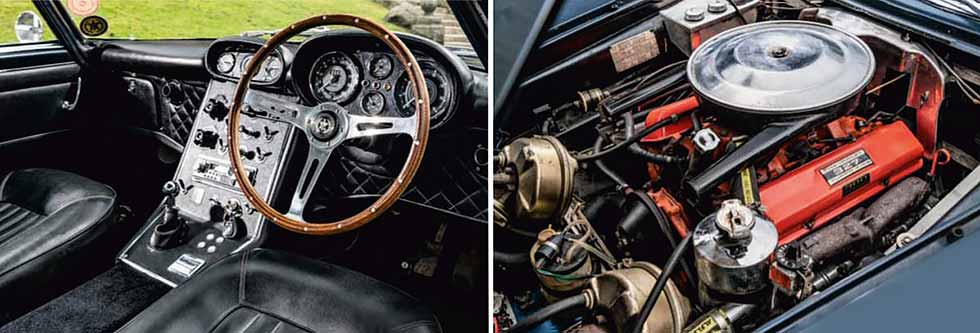
Verdict
We’ve been up hill and down dale, round pass and through village, endured a biblical soaking and basked in glorious sunshine. My senses have been soothed, scintillated and assaulted in equal measure by our gathered V8s.
A Bristol marks you out as a gentleman that appreciates the finer things in life, while the Mercedes-Benz 380 SLC C107 is a rugged, yet sophisticated package. Driving both is an effortless pleasure. I don’t quite have enough miles on my own clock yet for their smooth, luxurious wares to fully appeal – perhaps in a decade’s time.
The big, brash and bolshie Aston is a statement car. Gentlemen drive a DB5, but it’s V8 all the way if you have even a hint of rogue in your soul. But it’s too pricey for this one. The MGB GT V8 is the real surprise. Forget what year it was made, it’s a thoroughly enjoyable Sixties sports tourer that won’t break the bank.
But I only have eyes for one. I thought it’d be the Porsche 928. Futuristic lines that have matured well, allied to powerhouse performance – ideal for this youngtimer. My world though, has turned a little bit tortoise. Take noise, poise and grunt, then throw in ease of maintenance, reliability, exclusivity, sleeper kudos, and that loud loud pedal and for me it’s the Gordon Keeble by a nose. Though any would grace the gravel driveway of a country pile.
Thanks to: Bristol Owners’ Club (boc.net), The Independent Porsche Enthusiasts Club (tipec.net), The Aston Martin Owners Club (amoc.org), The MG Car Club (mgcc.co.uk), V8 Register (v8register.net), Gordon Keeble Owners Club (gordonkeeble.org.uk), and Upper House Hayfield (upperhousehayfield.com)
